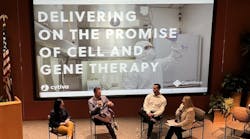(Editor’s Note: Click here for a podcast discussion with Jim Akers about trends in aseptic processing, including the reduction of the human element and the rise of automation.)
Jim Akers believes that you are dirty. Nothing personal, but to one of the leading experts in pharmaceutical aseptic processing, any human in a pharmaceutical plant is no different than Pigpen from Peanuts.
“It is safe to assume that the operator is always contaminated,” says Akers, principal of Akers, Kennedy, and Associates as well as the chair of the microbiology and sterility assurance committee for USP. Akers is also affiliated with aseptic equipment OEM Shibuya. “An operator is really a ‘mobile contamination generator,’ and the further we get this MCG away from the area in which he/she can affect the product, the better off we’ll be.”
Akers, speaking recently on aseptic processing and packaging at Chicago’s annual Pack Expo, backs up his filthy ideas, noting that various research has concluded that:
- Human operators in new gowns may release up to 1,000 CFUs (colony forming units) into the environment of their work.
- Sterile gowns lose filtration effectiveness as they are subjected to washing and sterilization cycles.
- The more intensely we ask operators to work, the more likely they are to contaminate the environment.
There are things that drug manufacturers can do to reduce MCG risk. Better ventilation and air movement is one, investing in improved gowning materials with better coverage and filtration properties is another. But the most significant countermeasure we can take to reduce the risk of contamination is to increase packaging machine automation in order to reduce the need for direct intervention. “The best intervention is the one that doesn’t get done.” In other words, we need to remove the human element from the processing space altogether. We’ve come a long way in the past 10 to 15 years, says Akers, but “no conventional manned system will ever be good enough.”
Flawed Analysis
Akers has another cause for concern. Our current methods of sterility assurance are flawed.
Akers lists the four legs on the assurance stool:
- Pre-filtration bioburden
- Process simulation testing
- Environmental monitoring
- Training and validation
Three of the four legs rely on our metrology and analytical capability. How good are these tests? Can we track bioburden in a meaningful manner?
“The microbiologist in me requires me to inform you that these measurements are pretty lousy,” Akers continues. “I believe that microbiological standards that have evolved in our industry did so without any real critical thinking about metrology or analytical capability.” Included in these standards are FDA’s aseptic processing guidelines and the EU’s Annex 1.
Akers explains: Knowing that we could never truly measure the number of CFU’s in a given sample, “we pushed our levels down [for measuring sterility], and we’re at a level where we statiscally can’t interpret the data,” he says. In microbiology, “zero doesn’t mean zero.” All measurements are subject to error, and it is impossible to truly discriminate between, for example, the level of 1 CFU vs. 5 CFUs.
“Our current sterility test is destructive and we typically test 40 units for lots of more than 100,000 containers,” Akers continues. “At a contamination rate of 0.1%, the chances of finding a non-sterile unit are close to zero. Proving the sterility in aseptic packaging by the means we currently use is impossible. . . . We’re trying to make a claim—absolute sterility—that we can’t really prove.”
The Path to Progress
It’s time that we take advantage of two available technologies, Akers says: separative technologies such as barriers and isolators, and automation.
Separative technologies represented a major paradigm shift when they emerged in the 1990’s, says Akers. With the advent of restricted access barrier systems (RABS), there was the hope that we could have a system that mitigated risk with some flexibility. But if that system involves gloves, it’s not good enough. “Gloves can fail,” Akers says.
Akers’ solution is a marriage of separative technologies with full-on automation. “We are on the cusp of gloveless isolators and truly unmanned aseptic processing,” he says.
The best examples of this, unfortunately, are not in pharma but in industries such as food and beverage, Akers says. “There are about a million industrial robots in use,” he says. “I don’t agree with the theory that robots are too untested to use in an aseptic environment. We need to move forward . . . we’re lagging 15-20 years behind the technology curve.”
Several conditions must be met for automation to be the solution. Components must feed smoothly enough that misfeeds are rare. Equipment must be able to adapt to minor adjustments in processing. But gloveless processing is the future, Akers insists. To punctuate his talk, Akers showed several video clips of automated aseptic processing already in practice, such as one of gloveless gravimetric liquid filling.





